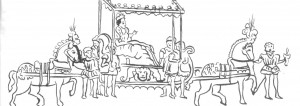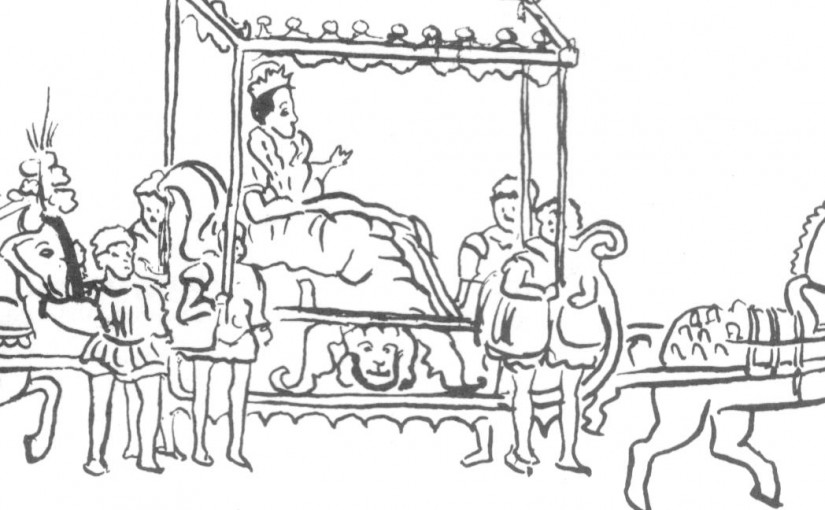400 years ago today – – – 11th. August 1573
Oyez, oyez, oyez! The whole population of Rye has been in a ferment of excitement for the last three days starting with the arrival of Her Gracious Majesty Queen Elizabeth at the Postern Gate of the town—White Friars Hill by the new Conduit—at 6.30 p.m. on Tuesday night 11th August until her departure for Ashford at 10 a.m. on Thursday morning, the 13th August, en route for Dover.
Her Majesty left Greenwich Palace on July 13th for Croydon where she spent a week with her mother’s old friend Archbishop Parker and on July 21st she moved to Orpington until July 24th when she went on to her own residence at Knole. On July 29th she left for Birling, remaining there until the first of this month when she left for Eridge and stayed there until Friday, 7th August, when she arrived at Bedgebury where she stayed with Mr. Alexander Culpeper and his wife, the former Miss Jane Burrell of Cuckfield. She visited his ironworks and furnaces in the area before moving to Corshorne House, Lord Cranbrook’s home, at Hemstead. Sunday was spent resting and another busy day on Monday touring the industrial area. This time it was not ironworks but cloth factories which she was to inspect and after visiting the famous factory at Cranbrook she walked the whole way back to Corshorne House, the roadway being spread the whole way for her feet—nearly a mile in length—with broadcloth from the Cranbrook looms. There was ample scope for royal souvenir hunters!
Tuesday morning her Majesty, always an early riser, set off a horse-back for Northiam where she took luncheon out of doors on the green and transferred to her horse-litter for the remainder of the journey to Rye in the afternoon.
The sun was dipping behind Leesam Hill when the Royal procession wound its way over the brow from Peasmarsh Place, past Marley to Tillingham Levels where Her Majesty paused for a few moments at 6 p.m. to inspect the Corporation’s newly improved waterworks at Dodeswell, and to take a sip of the Rye water supply thence conveyed in leaden pipes. Mayor Henry Gaymer was at Dodeswell to welcome Her Majesty and accompanied the retinue down the Grove across St. Mary’s marsh to Postern Gate where in view of the lateness of the evening she had chosen to make a modest entry into the town. Her Majesty, who was accompanied by six of her young Maids of Honour, was wearing a travelling habit in black and white cloth with pearls looped acrc~s the bodice, and a little felt hunting hat. She showed little sign of her exhausting trip when she arrived despite the hot sun and poor roads. It is rumoured that she rejected Mayor Gaymer’s proposal for a Royal entry past Saltcote Hill to Landgate because all her life Her Majesty has. had a particularly strong aversion to evil smells. “Tush man, your boots stink” she recently remarked to an unlucky courtier, and Mr. Gaymer may well have felt that the pungent whiffs of drying cod characteristic of Playden might well have rendered him liable to a truly Royal rebuke! Better therefore to avoid a formal entry via Landgate and to follow the course of the new Waterworks and Conduit, especially since Her Majesty is keenly interested in plumbing and has recently installed one of the new-fangled water closets at Richmond Palace, the invention of her godson Sir John Harington.

Also in the retinue were Mr. Thomas Walsingham, brother to Her Majesty’s newly appointed Secretary of State Sir Francis WaIsingham, who has recently returned from his post as Ambassador to France; and the Queen’s Bailiff Rye’s John Yonge (senior) who was to be Her Majesty’s host for Tuesday and Wednesday night at the Grene Hall by St. Mary’s Church.
On Wednesday morning, 12th August, after resting from her travels, Her Majesty held private audiences at the Grene Hall when some of Rye’s chief citizens were presented, and she took the opportunity to knight Mr. Thomas Shirley of Rye, whose family—his grandfather was King’s Bailiff from 1499-1524—had owned the Grene Hall, farmer! tycoon Thomas Guilford of East Guldeford, her Bedgebury host of three nights previously Mr. Alexander Culpeper, and her own Thomas Walsingham. We are able to include an artist’s reproduction of such a solemn and private scene, and those who cannot hope to enter Grene Hall can get a fine impression of the sort of room in which the Court took place by entering the Flushing Inn in La Boucherie nearby.
Her Majesty’s new Huguenot subjects—nearly a third of Rye’s population, and welcome replacements to the depleted populace after the frightful plague of 1563—were among those who cheered Her Majesty during her tour on foot of he town, still reeling as they were under the shock of the massacre of St. Bartholomew less than twelve months previously.
Her Majesty took a keen interest in the defences of the town, commenting at Gungarden “but Mr. Mayor, and where are my guns?” before touring the Fishmarket and boat yards. In an impromptu address to the fishermen she thanked them for the choice fish which were rushed by special packhorses to her table at Greenwich and which she especially prized. although she held a pomander to her nose as she accepted the traditional gift of Rye bloaters. She bade the boatbuilders to keep up their crafts since the time might be coming when she would have need again to call on her loyal Cinque Ports for help against the threatening navies of Spain. Reading between the lines, we cannot but think that she must also have been hoping for news among the Rye seamen of young Mr. Francis Drake who, it turns out, was even at that time just sailing into Plymouth from his second and lucrative attempt on the Spanish Peruvian treasure fleet at Nombre de Dios. Panama. Drake’s share of this enterprise cannot be less than £20,000 of our Tudor currency and rumour has it that Her Majesty, although not officially involved, has a private financial interest in these and other of Sir John Hawkins’ privateering expeditions in the Spanish Main.
Rye’s Own was not invited to the banquet at 5.30 p.m. at the Town Hall given to Her Majesty by Mr. Gaymer, his fellow Jurats. and the 24 new Prud’hommes, half chosen by the Mayor and Jurats, half by the assembled Coinmonalty of Rye, under Her Majesty’s new scheme. We understand that this new Common Council has not met very regularly in the intervening ten years but there was a scramble to establish membership in time for Her Majesty’s visit. Her Majesty returned early to Grene Hall, professing herself well pleased, but was late to bed, having dallied to nearly midnight listening to the music and joining in some of the dances. Between times she sat, in accordance with her pleasure when “on holiday”, on cushions on the floor beating time with her hands and correcting the movements of any dancers whose skill displeased her. A full day for Rye.
On Thursday morning 13th August Rye bade farewell to Her Gracious Majesty with a presentation on bended knee, again at the Postern Gate, by Mayor Gaymer of a purse of 100 gold angels. Her Majesty was in great good humour and—it is said, although we did not hear the words spoken ourselves—dubbed Rye “Rye Royal” in celebration of this happy visit. The whole populace were there to see the Royal procession set out for Hothfield, near Ashford, where Her Majesty spends Thursday night with the Tuftons, Earl of Thanet (and formerly of Northiam Place), and on Friday she moves on to Dover.
Rye will long remember this happy and intimate visit by our beloved Majesty and look forward to welcoming her successors in due course.
Farewell our Gloriana
0 happy town. 0 happy Rye:
That once in thee the Queen did ly, Such joy before was never seen
in Rye as now to lodge the Queen.
You fishermen of Rye rejoice:
To see your Queen and hear her voice
Now clap your hands rejoice and sing
That never erst lodged Queen or King.
Rejoice thou town and porte of Rye
To see thy Soverains Majestie
What hart hath ye that dwells in Rye
That joys not now as well as 1
Oh God that giveth life and breth
Preserve our Queen Elizabeth.
Errata
Since writing the above we have obtained access to Sussex Archaeological Collections Vol. 5 (currently missing from Rye Public Library) which adds some details to Queen Elizabeth’s tour and corrects and amplifies some points.
(1) She did not leave Rye, it would appear, until Friday, 14th August, not Thursday as stated above, having spent most of Thursday on a visit.to Winchelsea.
(2) It is not clear whether it was Thomas or Francis Walsingham who was present.
(3) Rye’s Thomas Shirley was at that time Treasurer of Her Majesty’s Army in the Low Countries.
(4) She did not proceed from Rye direct to Hothfield. Instead she returned via Northiam to Sissinghurst (Mr. Baker’s) where she spent the weekend, moving on on Monday, 17th August to Boughton Malherbe (Mr. Wotton’s) whence she left on Wednesday 19th for Mr. Tufton’s at Hothfield.
(5) She spent the following weekend at Westonhanger and on Tuesday 25th she visited Sandgate and Hythe en route for Dover Castle where she spent five days.
(6) On Monday, 31st August she went on to Sandwich where she spent four days, returning to Greenwich after a fortnight in Canterbury.
(7) This whole “Cinque Port Tour” lasted ten weeks
“Rye’s Own” August 1973
All articles, photographs and drawings on this web site are World Copyright Protected. No reproduction for publication without prior arrangement. © World Copyright 2015 Cinque Ports Magazines Rye Ltd., Guinea Hall Lodge Sellindge TN25 6EG
